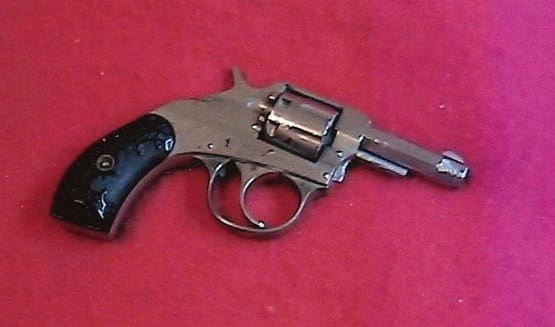“Two men who were convicted of gun charges after fleeing from police in Boston in February 2009 got a break today from the state’s highest court – because the gun they allegedly possessed illegally was made before 1900,” boston.com reports. “Ordering a new trial in the case, the Supreme Judicial Court said state gun licensing laws do not apply to guns manufactured before that year. ‘A person does not need a license to carry a firearm made before 1900,” the court said. The court noted that the Legislature had a valid purpose in making the exemption, ‘namely to allow individuals to carry antique firearms to Revolutionary War and Civil War reenactments.'” Someone needs to talk to the judge about historical timelines. Anyway, question . . .
How long before bank robbers dress up as Minutemen?
The defendants’ expert had testified, based on the serial number, that the Harrington & Richardson, .32-caliber five-shot revolver that police said was connected to the two men was made in 1896 and was a collectible.
Well if it wasn’t before it is now. One caveat:
In the future, the court said, if a defendant has evidence that the gun they were charged with possessing illegally was made before 1900, the defendant must tell prosecutors before trial. The burden then rests on prosecutors to prove the gun was made after 1899.
So I guess that means that possessing the gun may not be a crime but the criminal who uses it for criminal purposes is still committing a crime. Who knew?





I wonder if this extends to reproduction cap and ball revolvers since most reenactors carry reproductions.
Yes it does. It also applies to weapons for which ammunition is no longer commercially available.
Somehow, I doubt thugs are going to be robbing banks with black powder revolvers any time soon. Or at least with a loaded one.
I will be waiting in earnest for the first “My Glock was made in 1899” defense………
Wouldn’t stand a chance; Glock pistols weren’t made until the early 1980’s.
How long till the Commonwealth adds an “LTC Class C- license to carry flintlocks”?
Does that mean I can rob a bank with my mobile gatling gun and get away with it?
Of course you can. The gun is a sentient being, you didn’t rob the bank, your gun did. Clearly you are not responsible for robbing the bank, it was the gun’s fault. And since your gun is not illegal, no crime was committed. Enjoy your gun’s ill-gotten gains.
There is a famous story around South Florida of a guy who used his dad’s old gun to rob a bank. Even though he got about $300, the police confiscated the gun a few days later, and sold it at auction for $900.
In short, he would have been $600 better off just selling the gun instead of using it. Special criminal award: The gun helped the police catch him. It was an old Hopkins Allen .38, and easy to identify from the video.
“if a defendant has evidence that the gun they were charged with possessing illegally was made before 1900, the defendant must tell prosecutors before trial”
Does anyone else think that looks like really really bad precedent? It is -I thought- a longstanding tenant of the justice system that the defendant doesn’t have to tell the prosecution anything. Last time I served on a jury, the prosecutor had to bring in an expert to testify that the gun was functional. The defendant didn’t have to claim that it wasn’t functional; the cops just had to prove that it fell into the category of firearms that can’t be carried without a license.
“if a defendant has evidence that the gun they were charged with possessing illegally was made before 1900, the defendant must tell prosecutors before trial”
Is the defense legally required to provide exculpatory evidence to the prosecution pre-trial?
“The burden then rests on prosecutors to prove the gun was made after 1899.”
Hasn’t the burden of proof always been on the prosecution?
Okay, we see how criminals benefit from this, but what are the possible implications for otherwise law-abiding citizens who can’t (for whatever reason) get the proper licensing? Or does it become super secret double illegal then?
A gun made before 1900 isn’t a firearm within the meaning of MA’s firearm licensing scheme. The Federal law is different. To be a Federal antique and not a firearm, the pistol (i) would have to be made prior to 1899, and (ii) cannot use rimfire or centerfire ammo (unless that ammo is no longer available).
So the revolver in this case is not a firearm but is a firearm. Got that?
Not quite. Under federal law it’s or, not and.
Antique firearm includes (1) all guns manufactured in or before 1898 (ammo type not relevant),
or
(2) a replica of any firearm manufactured in or before 1898 that does not use rim-fire or center-fire ammo (unless that ammo is no longer available),
or
(3) certain black powder muzzle loading rifles, shotguns, or pistols (see the reg for exact requirements – 18 U.S.C., § 921(A)(16)).
State laws vary as to what you can or can’t do with an antique firearm. Huge difference between California and Texas for example. But note this was a possession with no license case, not the use of in a crime case – an antique can still be deadly weapon.
And the whole “tell the prosecutor” thing is a discovery requirement that varies by state. It doesn’t shift the burden of proof. Kinda like to have to give notice if you’re going to raise an insanity defense.
Is there no link to the original news story?
“Is there no link to the original news story?”
[url=http://www.boston.com/Boston/metrodesk/2012/04/supreme-judicial-court-license-needed-the-gun-was-made-before/jfTrX58cQiSBs3KrUkSz0H/index.html]Boston.com[/url]
I wasn’t allowed to edit my post, but here is the link.
http://www.boston.com/Boston/metrodesk/2012/04/supreme-judicial-court-license-needed-the-gun-was-made-before/jfTrX58cQiSBs3KrUkSz0H/index.html
Hear that? It was the sonic boom of people running to buy original issue 1899 Smith and Wesson M&Ps.
Just want to say your article is as surprising. The clarity in your puut up
is just great and i can assume you are a professional
in this subject. Fine together with yor permission let me to grasp your
feed to stay updated with approaching post. Thanks
1,000,000 andd please continue thhe enjoyable work.
Comments are closed.